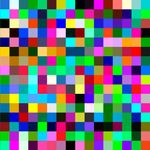 Adobe Community
Adobe Community
RGB to CYMK Blues Help
Copy link to clipboard
Copied
Hi there, I have an artwork I have photographed and need to covert to CYMK for printing, have gone through all options I can think of to get this royal blue better in CMYK ... any ideas??! It's so flat in comparison...
RGB
CMYK
Such a shame to loose such nice colour...
Explore related tutorials & articles
Copy link to clipboard
Copied
It's out of gamut - it cannot be reproduced in the target CMYK color space.
CMYK represents actual physical inks on actual paper. That's the limit you're hitting.
Every CMYK profile represents a specific offset print process - a certain ink set on certain paper stock, on an offset press calibrated to a certain standard. There is no such thing as a universal "generic" CMYK. So make sure you are using the appropriate CMYK profile.
(just so it's said, CMYK is for commercial offset print - if this is printed on an inkjet printer, keep it RGB and proof to the appropriate print profile to see where it's out of gamut).
Copy link to clipboard
Copied
Especially if this is going to a press…Reproducing deep blue in CMYK is a classic printing problem that has existed for the entire history of CMYK printing, going back to its early days over 100 years ago. Unfortunately, Photoshop can’t address this basic problem (this is a problem you would run into with any photo software), because the root cause is that the color range that CMYK inks can reproduce is smaller than the range of colors you can get from paint pigments or on an electronic screen.
Keep in mind that every intense, apparently saturated blue you see in every CMYK-printed poster or coffee table book is likely a weaker blue than was in the original photo, or it’s more cyan than you think. If you open a professionally printed high quality art book with reproductions of paintings famous for their intense blues, you can bet that the CMYK blues that look impressive in the book are not nearly as saturated as the blue pigments in the real painting, because they were under the same limitation of CMYK inks. The only reason you never notice this is that you don’t typically have the original painting next to the book for comparison.
The picture below, made with Apple ColorSync Utility (which comes with every Mac so you can try this yourself), shows the color coverage of Adobe RGB compared to the profile for a CMYK standard for coated paper. If your job targets a CMYK profile representing uncoated or lower quality paper, the CMYK color coverage is even smaller.
There’s no easy solution, so some ways people handle this are:
- Adjust the CMYK channels to either get the best blue possible under the available limited color gamut, or adjust other colors to make the available blue appear more intense using the principles of color theory and color contrast. Dan Margulis is a color expert who is very good at doing this with Curves in Photoshop.
- In the Edit > Convert to Profile dialog box, in the Intent menu, see which one works better: Perceptual or Relative Colorimetric. But when trying a different rendering Intent, always check to see if all other color relationships in the image are still OK.
- Ask the printing company if there is an option to add an actual blue ink to the CMYK inks. This is not common, because adding inks increases the printing budget, and it’s more work because now you’re not editing in CMYK, you’re editing in CMYK plus a blue spot ink and have to set up and properly edit your Photoshop documents that way (add a spot color channel). Also, adding a spot color is not usually a practical option for photographs, it’s more appropriate for graphics and logos.
- Only specify blues that your target CMYK profile is known to be able to reproduce, using a CMYK swatch book. That works for design, but not for photographs where the blue saturation was recorded by the camera as outside CMYK gamuts.
- Adjust expectations, knowing that the most saturated blues simply can’t be reproduced in CMYK.
Copy link to clipboard
Copied
What is the CMYK target condition? There's no generic CMYK. Different profiles for the same target condition may offer greatly different rendering results for out of gamut colours.
As blue doesn't exist in CMYK, it's created by mixing cyan and magenta. Once magenta values become too high there's a hue shift to purple. You either account for this pre or post conversion. Do ensure that you remove all yellow in such a scene. You can move a fraction of the yellow into the black for contrast.
Copy link to clipboard
Copied
@Stephen_A_Marsh "As blue doesn't exist in CMYK, it's created by mixing cyan and magenta. Once magenta values become too high there's a hue shift to purple. You either account for this pre or post conversion"
well explained
@Kati250454758v7x think about the watercolour artist/painter, they can do good job of stimulating the scene, but they often cannot MATCH the actual colours. They scale the colour of the whole scene to match the range of colour they CAN get on the paper. For sure it's not as bad in a good CMYK offset process but it is effectively the same situation
I hope this helps
neil barstow, colourmanagement net - adobe forum volunteer - co-author: 'getting colour right'
google me "neil barstow colourmanagement" for lots of free articles on colour management
Help others by clicking "Correct Answer" if the question is answered.
Found the answer elsewhere? Share it here. "Upvote" is for useful posts.



